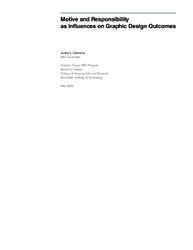| dc.contributor.advisor | Beardslee, Deborah | |
| dc.contributor.advisor | Robison, Wade | |
| dc.contributor.advisor | Steinberg, Loret | |
| dc.contributor.author | Clements, Jackie | |
| dc.date.accessioned | 2009-06-05T14:25:12Z | |
| dc.date.available | 2009-06-05T14:25:12Z | |
| dc.date.issued | 2009-05 | |
| dc.identifier.uri | http://hdl.handle.net/1850/9733 | |
| dc.description.abstract | In the world of visual communication many message-making strategies are used to convey information to a defined audience. The ways in which these strategies are used can greatly impact the meaning and success of a graphic design solution. Often strong emotion is employed to intentionally influence a defined audience. In addition, the format and context in which facts are presented in a message are also greatly effective.
When looking at the potential communication power that solutions can hold, it is important to assess the types of messages being communicated and related ethical responsibilities that accompany them. This thesis study focuses on single-page, printed promotional messages specifically created to have strong influences on their respective viewers. When creating promotional messages the client may have specific motives, responsibilities, content and requirements that the designer should be aware of. Both the client and designer may share the responsibility for how that content is represented. The audiences of these messages are also responsible to think critically about the messages being presented to them.
This thesis aims to define clearly the ethical responsibilities of the client, designer and audience when examining promotional messages. These definitions are defined through research done within the areas of graphic design and related fields, and the analysis of the semantic and syntactic decisions made in relation to selected, relevant promotional messages. The analysis of existing promotional messages led to a design application that focuses on the development of multiple, potential symbols for a single entity in order to examine how the interpretation of a message varies when different message-making strategies are used. The strategies used in this application focus on specific syntactic decisions that relate to the diverse factual and emotional goals of each solution. | en_US |
| dc.language.iso | en_US | en_US |
| dc.relation | RIT Scholars content from RIT Digital Media Library has moved from http://ritdml.rit.edu/handle/1850/9733 to RIT Scholar Works http://scholarworks.rit.edu/theses/4921, please update your feeds & links! | |
| dc.subject | Audience interpretation | en_US |
| dc.subject | Ethical responsibility | en_US |
| dc.subject | Graphic design | en_US |
| dc.subject | Message-making strategies | en_US |
| dc.subject | Promotional messages | en_US |
| dc.subject | Visual communication | en_US |
| dc.subject.lcc | NC1002.L63 C54 2009 | |
| dc.subject.lcsh | Logos (Symbols)--Moral and ethical aspects | en_US |
| dc.subject.lcsh | Graphic arts--Moral and ethical aspects | en_US |
| dc.subject.lcsh | Advertising--Moral and ethical aspects | en_US |
| dc.subject.lcsh | Visual communication--Moral and ethical aspects | en_US |
| dc.title | Motive and responsibility as influences on graphic design outcomes | en_US |
| dc.type | Thesis | en_US |
| dc.description.college | College of Imaging Arts and Sciences | en_US |
| dc.contributor.advisorChair | Lachance, Patti | |
| dc.description.school | School of Design | en_US |

